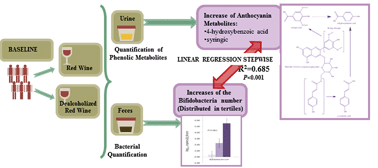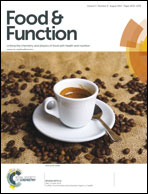High levels of Bifidobacteria are associated with increased levels of anthocyanin microbial metabolites: a randomized clinical trial†
Abstract
The health benefits associated with the consumption of polyphenol-rich foods have been studied in depth, however, the full mechanism of action remains unknown. One of the proposed mechanisms is through microbiota interaction. In the present study, we aimed to explore the relationship between changes in fecal microbiota and changes in urinary phenolic metabolites after wine interventions. Nine participants followed a randomized, crossover, controlled interventional trial. After the washout period, they received red wine, dealcoholized red wine or gin for 20 days each. Polyphenol metabolites (n > 60) in urine were identified and quantified by UPLC-MS/MS and the microbial content of fecal samples was quantified by real-time quantitative PCR. Interventions with both red wine and dealcoholized red wine increased the fecal concentration of Bifidobacterium, Enterococcus and Eggerthella lenta, compared to gin intervention and baseline. When participants were categorized in tertiles of changes in fecal bacteria, those in the highest tertile of Bifidobacteria had higher urinary concentration changes in syringic acid, p-coumaric acid, 4-hydroxybenzoic acid and homovanillic acid (all anthocyanin metabolites) than those in tertile 1 (P < 0.05, all). In addition, changes of Bifidobacteria correlated positively with changes of these metabolites (r = 0.5–0.7, P < 0.05, all). Finally, the 68.5% changes in Bifidobacteria can be predicted by syringic acid and 4-hydroxybenzoic acid changes. This study confirms the important role of polyphenols as bacterial substrates and their modulatory capacity as an important field in the research of new products with prebiotic and probiotic characteristics for the food industry.

- This article is part of the themed collection: VI International Conference on Polyphenols and Health

 Please wait while we load your content...
Please wait while we load your content...